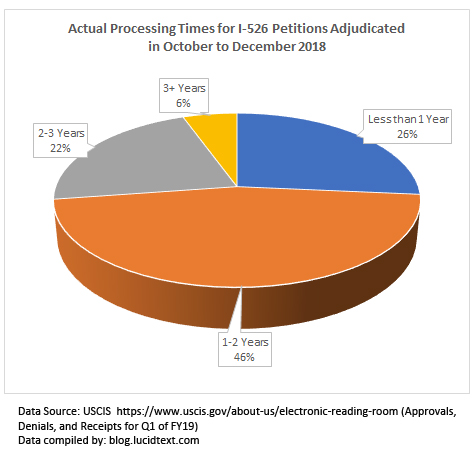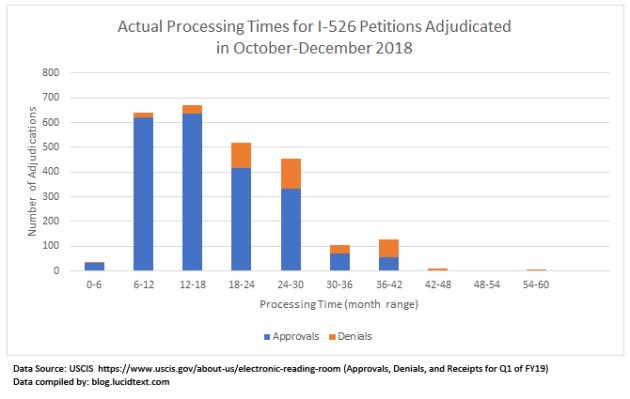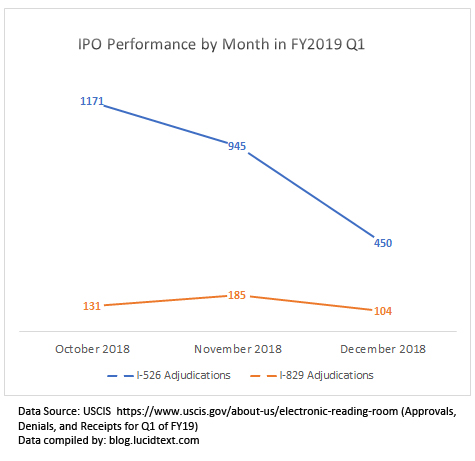Complete I-526 and I-829 data for FY2019 Q1, by country
March 5, 2020 25 Comments
Buried deep in the Electronic Reading Room, where USCIS probably hoped no one would ever find them, are two Freedom of Information Act files that individually record every I-526 and I-829 receipt and adjudication from October to December 2018 (FY2019 Q1).
- I-526 Approvals, Denials, and Receipts for Q1 of FY19 (PDF, 812 KB)
- I-829 Approvals, Denials, and Receipts for Q1 of FY19 (PDF, 258 KB)
Being diligent, I discovered the files, and immediately converted them to Excel and got to work with pivot tables. This data allows fact-based answers, at least for one quarter, to questions generally subject to rumor and speculation.
- How do USCIS processing times reports relate to actual processing times?
- Have petition processing times differed by country?
- Do approval rates differ by country?
- From which countries are I-526 receipts coming?
Before considering answers to these questions from FY2019 Q1 data, consider FY2019 Q1 in context.

IPO apparently made dramatic processing changes between 2018 and 2019, and FY2019 Q1 has one foot on either side of that change. So what happened in FY2019 Q1 isn’t necessarily representative of what came before or after. But for what it’s worth, here’s analysis of exactly what happened in that one quarter.
- Processing Times Questions
- Back in December 2018, the USCIS processing times report gave an “Estimated Time Range” of 20.5-26 months for I-526, and 30-39 months for I-829. USCIS claims that in this range, “The first number is the time it takes to complete 50% of cases (the median). The second number is the time it takes to complete 93% of cases.” Presumably, these percentages get calculated from data for the previous month or two.
- In reality, according to FY2019 Q1 data reports, 64% of I-526 adjudicated in October-November 2018 had been pending less than 20.5 months. 79% of I-829 adjudicated in October-November 2018 had been pending less than 27.5 months. Meanwhile, 16% of I-526 and 14% of I-829 adjudicated had been pending longer than the outer limit of the reported estimated time range.
- In FY2019 Q1, the actual processing times for adjudicated I-526 and I-829 were quite a bit lower on average than the processing times report would suggest, and also had more deviation from average. The link between the contemporary processing times report and actual performance is not clear. Generally, the reality was somewhat better than the report.
- The average I-526 approved in FY2019 Q1 had been pending 17.5 months, while the average approved I-829 had been pending 26 months.
- Country Questions
- Data on I-526 adjudications for FY2019 Q1 shows differences by country, but not enough to suggest that USCIS was already using a visa availability approach last year.
- The average processing time for Chinese I-526 approved in FY2019 Q1 was just two months longer than the average for other countries.
- The average processing time for India I-526 approved in FY2019 Q1 was almost five months shorter than the worldwide average, likely due the influence of expedite requests. Indians accounted for 30 of the 36 I-526 processed in FY2019 Q1 within six months of filing.
- Indians accounted for a majority (31%) of the I-526 filed in FY2019 Q1, followed by China (15%), Vietnam (11%), and South Korea (6%). Indians filed enough I-526 just in Q1 to use up over a year and half of the EB-5 visa quota for India.
- Chinese, as might be expected considering past demand trends, accounted for the majority of I-829 filed (81%) and adjudicated (81%) in FY2019 Q1.
- The I-526 approval rate in FY2019 Q1 was over 90% for most countries, but just 81% for China. I suspect this is due to USCIS’s surreptitious policy change regarding currency swaps, which particularly affects China.
- Other Notes:
- The records show that USCIS codes at least two kinds of I-526 denial: Denied Fraud, and Denied Others. In FY2019 Q1, only one petition was denied due to fraud.
- USCIS may not have its best and brightest on data entry and record-keeping. The “country” column for I-526 receipts, for example, includes 20 petitions coded as coming from Falkland Islands (presumably standing for Great Britain, where DOS categorizes Falkland Islands), 13 from “Unknown,” 8 from USSR, and 1 from United States. Also the totals for the quarter do not exactly match the official report of I-526 and I-829 data for FY2019 Q1. (For example, 1,808 I-526 receipts in the official quarterly report; 1,743 I-526 receipts recorded in this detailed report.) However, please do not be shy USCIS: publishing slightly inaccurate records is a thousand times better than hiding data, leaving the industry to rumor and speculation.
- It’s always been clear that EB-5 processing is not simply First-In-First-Out. The USCIS Estimated Time Range for processing would obviously not be so broad under a FIFO system, and the range in actual processing times is even broader. But what explains why some petitions have been processed years earlier or later than others? One factor that’s obvious in the data — denial decisions go “out” much later than approvals.
- To repeat: petition processing has not been strictly FIFO. This is clear, looking at the dates of petitions that received decisions in this one quarter. The PDF files linked above record individual decisions. If the FY2019 Q1 record shows that one I-526 with X filing date got approved or denied, does that mean that every I-526 with X filing date has been adjudicated? No.
And now some charts based on the FY2019 Q1 data.
I’m compiling materials for a new data room, and hope to launch a new processing time estimate service later this month following the EB-5 stakeholder meeting with USCIS.
And a few legislative notes. Senator Mike Lee continues to work on the S.386 Fairness for Highskilled Immigrants Act to eliminate country caps and reorganize the order of EB visas. Could the bill that’s been on the table since 2011 actually move in 2020? I doubt, but Lee is pushing hard. The competitor RELIEF Act has just a few sponsors so far.
Meanwhile, bright-eyed representatives Cardenas (D-CA) and Stivers (R-OH) have introduced H.R. 5971 Case Backlog and Transparency Act of 2020. This bill refers back to P.L. 106-313, which was passed in the year 2000 with this beautiful sentence in section 202: “It is the sense of Congress that the processing of an immigration benefit application should be completed not later than 180 days after the initial filing of the application.” (p. 12) H.R. 5971 proposes to revive that deadline, and require DHS to report in detail on backlog reduction efforts. Lovely! If only the current Congress could agree that immigration benefit applications should be processed efficiently.
And as always, my PayPal link is open. If my work to find and analyze data is helpful and time-saving for you, consider making a contribution to support the work. And thanks to my past contributors!








My name is khalid Hussain Shah im from Kashmir Pakistan now im in Saudi Arabia Riyadh I like to apply work Visa work permit have possible you help me please
Hi Suzanne,
Great work and thank you for finding these files. Awesome analysis as well. Looking at the file itself, I was hoping to find my receipt date and couldn’t find it in the approvals, denials or the Init Receipt Milestones. My receipt’s date for I-526 is 09/27/2018 and it says the same date under priority date with a Preference Classification of 203 B-5 I-526 on my receipt. Where do you think I could fall? Thanks
A priority date of 9/27/2018 would be in a report for FY2018 Q4, but unfortunately USCIS has not yet published detail for that quarter. The unusual report I link in this post only covers FY2019 Q1.
Excellent information! As usual.
One small thing stroke me as odd. How can it be that 20 investors claimed to be born in the Falkland Islands/Malvinas? The archipelago has a population of less than 3,000! Considering that each investor brings a family of 3, this 20 investors represents 2% of the archipelago’s population.
How can there be so many wealthy people in a not very developed archipelago and all decided and succeeded to apply to EB5 at the same time?
The archipelago is not an independent nation. Is USCIS/DHS considering as such for practical terms?
I have two explanations. First is that someone in the Island government is selling fake birth certificates to Chinese investors. Second, is that is a typo…
In the same line, how can there be 13 investors whose place of birth is Unknown? Or are they from countries that don’t exist any more (i.e. Czechoslovakia, Yugoslavia)?
Found at least 5 investors from the USSR, so no, Unknown cannot be from countries that do not exist today.
Haha, right.
Good points — I should add a note to the post. Falkland Islands means Great Britain so far as DOS is concerned (https://travel.state.gov/content/dam/visas/Statistics/AnnualReports/FY2019AnnualReport/FY19AnnualReport%20-%20TableV.pdf) — it is funny that USCIS would choose that row title for all UK. The report truly does have 20 rows for Falkland Islands and not with identical priority dates, so the entries don’t look like typos in themselves. That “unknown” is a mystery. Maybe the person doing data entry just forgot to enter origins for those dates.
Thanks so much for the valuable info. I would assume the average 829 approval waiting times since the data above would have become longer by six(?) months at least? What do you think?
The USCIS processing times reports for I-829 suggest that the distribution of I-829 wait times has increased, with 50% of I-829 adjudicated six months faster than before, and 7% adjudicated 12 months later than before. (Considering that the “Estimated Time Range” increased from 27.5-35.5 in Decimeter 2018 to 22-27.5 today.)
My 829 submitted on April of 2017. Getting close to 3 years now. Will update you if I hear anything.
I’m the same. June 2017. Which project are you?
Canam
I just got my permanent green card. Despite the pandemic, USCIS staff must be working hard. You should receive your green cards in a few months.
suzanne i will contact you after either march 13 or 31 for my i 526 priority date is sept 2017 and not adjudicated yet, hope new rule will help me
In the PDF documents how does one interpret the column names “Init Rcpt – Date Calendar” and “Ms Impl – Date Calendar”?
My interpretation (based on no expert knowledge, just context) is that “Init Rcpt – Date Calendar” must mean the receipt date for that form, while “Ms Impl – Date Calendar” means the date of the action recorded in the third column.
Init Recpt – Initial receipt date of the application
Ms Impl – Mission Impossible???
Also what does it mean (b)(6) under Receipt Number column ?
Hi Suzanne!
Excellent information & great work as usual.
I am an Indian & my I-526 priority date is 27 Apr 2017 & still waiting. As per report, this priority date applications were processed during oct/nov/dec 2018. what could be the reason for this much delay for my application? When can I expect any action for me?
I-526 processed since April 2017 > I-526 pending in April 2017
So all April 2017 priority dates should’ve been processed already, if processing had been in FIFO order. Apparently processing hasn’t been FIFO and your case among others were unfairly left behind, possibly for no particular reason. You’d probably have a good case, if you wanted to file a mandamus. https://wolfsdorf.com/blog/2019/12/05/mandamus-lawsuits-on-delayed-eb-5-adjudications/
Hi Suzanne – thanks for sharing the links. Does IPO also review funds used to pay the regional center admin fees during the i526 process?
Hi Suzanne,
My I526 is 03/30/18 but no feedback while denial list is stopped 03/28/10 to 10/1/2018. I don’t know what happened to these numbers among the time while initial list is from 10/1/18 to 12/29/18. Can you explain, Suzanne?
Many thanks for your reply.
The PDF files that I discuss in this post simply record each I-526 that received a decision October 2018 to December 2018. These I-526 had a wide range of filing dates, because USCIS has not been processing petitions strictly in date order. Many other petitions with the same filing dates are still pending.
Hi Suzanne,
My I526 was filed on the 26-Mar-2018 and I’m an Indian national. The latest Visa Bulletin (and the other recent ones) indicates Final Action Date being later than my priority date.
I haven’t heard on my case and on tracking online, the status still says “Case Was Received” – What could this potentially imply?
Is it safe to assume that my I526 should be processed by now or does it mean my application could still be under processing?
At what stage would the status of the file usually progress from Received?
Recall that I-526 processing has been independent of visa availability. The final action date in the visa bulletin from Department of State does not indicate when an I-526 will be adjudicated by USCIS. See this post for discussion: https://blog.lucidtext.com/2020/01/17/2-2020-visa-bulletin-india-fad/ The picture will change somewhat starting in April when USCIS starts to implement a visa availability approach to EB-5 processing. We’ll see how it changes.